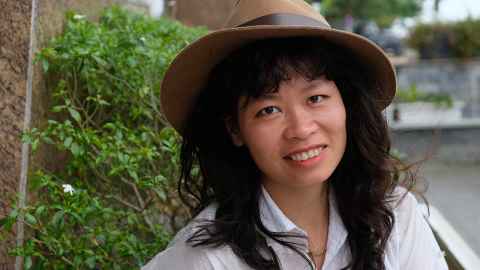Take 10 with... Tra Dinh
Tra Dinh, Department of Physics, gives us 10 minutes of her time to discuss her research on how clouds and precipitation vary in time and space.

1. Describe your research topic to us in 10 words or less.
I study clouds and precipitation on Earth.
2. Now explain it in everyday terms!
Clouds and precipitation vary in space and time. The weather systems that form different types of clouds and precipitation are very different between the tropics and the higher latitudes. The types of clouds also vary with height in the atmosphere. Clouds at lower altitudes are mostly liquid clouds, and those at higher altitudes are mostly ice clouds. Moreover, the amount of clouds and precipitation vary from day to night, season to season, year to year, and on longer time scales (decades to centuries). I study the physical processes in the atmosphere and at the surface that govern such variations in clouds and precipitation.
3. Describe some of your day-to-day research activities.
My daily research activities include data analysis, numerical modelling, thinking, writing, reading, attending and giving research seminars, and student supervision.
4. What do you enjoy most about your research?
Even with a busy work schedule, I try to reserve quiet hours or a day in the week during which I ponder about my research questions without being interrupted. I particularly enjoy these quiet times.
It has also been very rewarding to see that my students have grown to become independent researchers through the course of their training with me.
5. Tell us something that has surprised you in the course of your research.
Many things that I once thought were true, I no longer think are true after carefully considering all the evidence. In recent years, I have developed a habit of seeking out ideas that are contrary to my belief to challenge my thinking and prevent myself from falling into scientific dogma.
6. How have you approached any challenges you’ve faced in your research?
When I run out of ideas, I take a break and do something completely different, like take a walk, chat with a friend, or play the guitar. When I return to the tasks at hand, there are already several new ideas to try out, and I often solve the problems eventually.
7. What questions have emerged as a result?
Over the years, I have studied low-altitude and high-altitude clouds, and precipitation in the tropics and in the extratropics. The important processes underlying clouds and precipitation vary from place to place. However, I wonder if there is a universal physical constraint that governs the amount of clouds and precipitation globally. If it exists, what physical processes lead to such a constraint?
8. What kind of impact do you hope your research will have?
I hope my research will contribute positively to our ability to predict Earth’s weather and climate. I am optimistic that an improved understanding of the physics and the increasing availability of observational data will lead to significant progress in weather and climate prediction.
9. If you collaborate across the faculty or University, who do you work with and how does it benefit your research?
I have collaborated with Dr. Gilles Bellon in the Department of Physics, Dr. Melissa Bowen in the School of Environment, and Professor Bernd Krauskopf in the Department of Mathematics. They are very knowledgeable and talented people of their fields, from whom I’ve learned a great deal.
10. What one piece of advice would you give your younger, less experienced research self?
Work hard, but it is important to take care of your health. Only when you are healthy can you enjoy work and life in general.